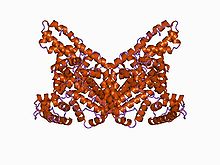
Back Albumin ALS ألبومين Arabic Albumin Azerbaijani Альбуміны Byelorussian Албумин Bulgarian অ্যালবিউমিন Bengali/Bangla Albumin BS Albúmina Catalan Albumin Czech Albumin Danish
This article has multiple issues. Please help improve it or discuss these issues on the talk page. (Learn how and when to remove these messages)
|
| Serum albumin family | |||||||||||
|---|---|---|---|---|---|---|---|---|---|---|---|
 | |||||||||||
| Identifiers | |||||||||||
| Symbol | Serum_albumin | ||||||||||
| Pfam | PF00273 | ||||||||||
| Pfam clan | CL0282 | ||||||||||
| InterPro | IPR014760 | ||||||||||
| SMART | SM00103 | ||||||||||
| PROSITE | PS51438 | ||||||||||
| SCOP2 | 1ao6 / SCOPe / SUPFAM | ||||||||||
| |||||||||||
Albumin is a family of globular proteins, the most common of which are the serum albumins. All of the proteins of the albumin family are water-soluble, moderately soluble in concentrated salt solutions, and experience heat denaturation. Albumins are commonly found in blood plasma and differ from other blood proteins in that they are not glycosylated. Substances containing albumins are called albuminoids.
A number of blood transport proteins are evolutionarily related in the albumin family, including serum albumin, alpha-fetoprotein, vitamin D-binding protein and afamin.[3][4][5] This family is only found in vertebrates.[6]
Albumins in a less strict sense can mean other proteins that coagulate under certain conditions. See § Other albumin types for lactalbumin, ovalbumin and plant "2S albumin".
- ^ Sugio S, Kashima A, Mochizuki S, Noda M, Kobayashi K (June 1999). "Crystal structure of human serum albumin at 2.5 A resolution". Protein Engineering. 12 (6): 439–46. doi:10.1093/protein/12.6.439. PMID 10388840.
- ^ He XM, Carter DC (July 1992). "Atomic structure and chemistry of human serum albumin". Nature. 358 (6383): 209–15. Bibcode:1992Natur.358..209H. doi:10.1038/358209a0. PMID 1630489. S2CID 4353741.
- ^ Haefliger DN, Moskaitis JE, Schoenberg DR, Wahli W (October 1989). "Amphibian albumins as members of the albumin, alpha-fetoprotein, vitamin D-binding protein multigene family". Journal of Molecular Evolution. 29 (4): 344–54. Bibcode:1989JMolE..29..344H. doi:10.1007/BF02103621. PMID 2481749. S2CID 1456034.
- ^ Schoentgen F, Metz-Boutigue MH, Jollès J, Constans J, Jollès P (June 1986). "Complete amino acid sequence of human vitamin D-binding protein (group-specific component): evidence of a three-fold internal homology as in serum albumin and alpha-fetoprotein". Biochimica et Biophysica Acta (BBA) - Protein Structure and Molecular Enzymology. 871 (2): 189–98. doi:10.1016/0167-4838(86)90173-1. PMID 2423133.
- ^ Lichenstein HS, Lyons DE, Wurfel MM, Johnson DA, McGinley MD, Leidli JC, et al. (July 1994). "Afamin is a new member of the albumin, alpha-fetoprotein, and vitamin D-binding protein gene family". The Journal of Biological Chemistry. 269 (27): 18149–54. doi:10.1016/S0021-9258(17)32429-8. PMID 7517938.
- ^ Li S, Cao Y, Geng F (2017). "Genome-Wide Identification and Comparative Analysis of Albumin Family in Vertebrates". Evolutionary Bioinformatics Online. 13: 1176934317716089. doi:10.1177/1176934317716089. PMC 5480655. PMID 28680266.